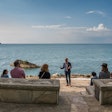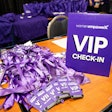
Last year, a Gallup poll reported that about 53% of American workers are expecting to continue with a hybrid work model moving forward. This has certainly led to some positive trends in things like employee well-being—but it also has led to some significant challenges regarding company culture, when executives can no longer count on employees to form natural connections on their own.
In fact, Microsoft’s annual work trend index revealed that 55% of hybrid employees and 50% of remote employees feel lonelier at work than they did pre-pandemic. When employees make deep connections with their team members and other colleagues, the Microsoft study adds, they’re more likely to report higher satisfaction, productivity, and creativity—and are less likely to change employers in the year ahead.
“When people trust one another and have [social] capital, you get a willingness to take risks, you get more innovation and creativity and less groupthink,” explains Microsoft’s principal researcher, Nancy Baym, in the report.
Of course, this doesn’t mean that simply forcing employees to return to an in-person environment is the solution. “People probably fondly misremember the good old days when employees were largely together in an office every day,” points out Lee Gimpel, an event strategist and president of Better Meetings in Washington, D.C. “There is certainly something to be said for the effect of proximity, but it's not like employees were waking up a few years ago excited to go sit in cubicles. Simply being in the same space isn't a panacea for more productive work or a great culture.”
The solution may lie in carefully considered, in-person events that offer employees not just the chance to work together, but also a more casual space for organic inspiration and team-building opportunities.
“There is great potential power in corporate events. If done right, they reinforce important bonds, build new bridges, and define and foster a strong culture,” says Gimpel, who is seeing a rise in more frequent, casual company retreats that bring in employees of all levels, rather than just upper management. “They offer an opportunity to get real work done while also rewarding people and making them happy that this is where they have chosen to work. A two-day event can pay dividends for months and months.”
Here are some tips for maximizing connection at your next company off-site, team-building event, incentive trip, or simply a routine internal meeting.
1. Have a very clear “why.”
Some good news: According to American Express’s 2023 Global Meetings and Events Forecast, internal meetings are now the fastest-growing event category in all regions, and are expected to see the biggest increase in attendees in 2023. So convincing the C-suite may be less difficult than expected—but clearly identifying the purpose for your internal event is crucial.
If you’re asking hybrid or remote employees to make the effort to attend in person, make sure the idea of connection is at the forefront, advises Gimpel.
“There is often a fair amount of magical thinking that goes into events. We have someone do a presentation and hope that it will magically be great. We plan a mingling session and magically think that it's going to create a real sense of camaraderie,” he points out. “We can make these things happen, but they rarely happen on their own, at least to the extent that we want them to. Companies should be really clear about why they're holding this event and what they want to get from it.”
Lee Hird, co-founder and director of Zentive Agency, a London-based events company focusing on CSR, technology, and sustainability, says that meeting with clients and pinning down main goals and objectives—and then keeping those in mind every step of the way—is a crucial first step. “If this stage isn't carried out, then planning the event is like driving cross country with no map or road signs. You really can't see your destination, and therefore you cannot plan or strategically execute an event program,” he says.
2. Establish a frequency that works for your goals.
Of course, it’s not enough to host one company off-site and expect it to pay dividends for years to come. In fact, Cindy Y. Lo, CEO of event and experience agency Red Velvet in Austin, recommends that companies with a majority distributed workforce host in-person get-togethers at least once per quarter.
“It doesn't necessarily have to be the entire company all-hands, but at the very least something where the distributed employee can meet some of their teammates in person,” she says, noting that many of her tech clients, in particular, are tightening budgets by doing more individual team meet-ups—but are still making a point to gather the entire company as a whole at least once annually.
Lo sees the flip side, too, and the ways that workers have shifted their priorities in recent years—and may not want to travel for company meetings regularly. “Since I am not proposing having something like this once a week or even once a month, the infrequency should actually be desired even by the most introverted employee,” she says.
3. Generate excitement beforehand.
In addition to finding the right cadence for internal events, the way the gathering is marketed beforehand is crucial for getting remote and hybrid employees excited and engaged. Fun fact: A study of more than 1,500 Dutch adults, published in Applied Research in Quality of Life, found that people going on a vacation experienced their highest level of happiness in the weeks and months before a trip. Although that study was focused on leisure travel, it shows that building excitement for a company retreat or incentive trip might be half the battle.
“This element of the event is crucial, because without buy-in from the employees, you are setting yourself up for a demotivated workforce and low morale event,” Hird notes. “I think the key to this is the communication, which is delivered ahead of the event in addition to creating a strong event theme and brand identity…Getting the event identity correct is a key factor in being able to convince employees to attend.”
4. Offer a mix of programming.
Once you get the team on-site, resist the urge to make things all work, all the time, adds Gimpel. “Especially with retreats, there is a temptation to put the group's collective nose to the grindstone and do a lot of work. Yet, if you ask why the company went to such trouble to arrange the retreat, the answer is often that team-building and cohesion are important,” he says. “It's not that you can't work and build camaraderie at the same time, but just sitting around a boardroom table for a day doesn't necessarily make a team much stronger—even if they go out to a nice dinner afterward.”
Hird suggests mixing it up throughout the day, and ensuring there’s a blend of downtime and networking sessions in addition to the work-focused elements. “You need to allow your employees time to bond and create the relationships that will drive the business forward,” says Hird, who personally has seen a rise in requests for team-building activities centered around CSR, sustainability, and giving back to the local community. “Team building doesn't need to be forced fun or cheesy...Who doesn't feel good about themselves when you are doing good for others?”
5. Above all, take a people-centric approach.
Like with any event, planning a good internal corporate event means putting yourself in the attendees’ shoes. Think about who your primary attendees are, and what might be standing in the way of them feeling fully connected in the workplace.
“A lot of corporate meetings and retreats are driven by an event planner, a manager, or an administrative assistant who inevitably focuses on the logistics," Gimpel explains. "As someone with a facilitation background who helps organizations design effective meetings, I would say that a strategic, people-centric component is often missing. I think it's really important to have somebody at the planning stage who will advocate for the people, the experience, and the connection while still understanding how to balance work and the event experience.”



















